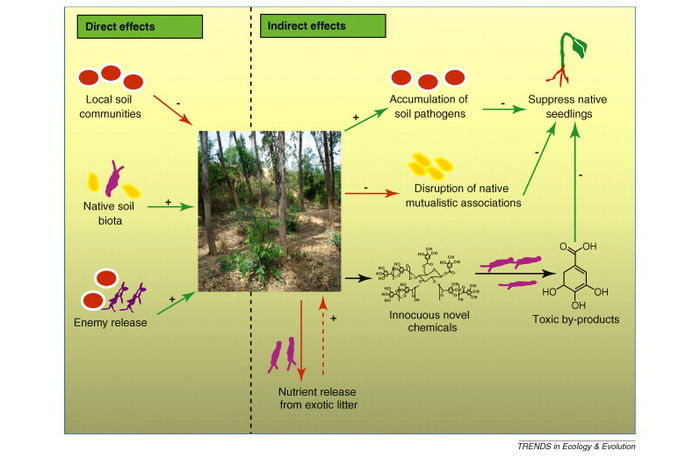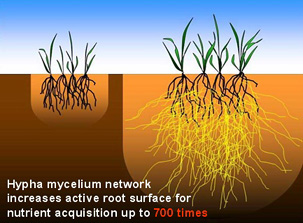Microbes and invasive plants
Introduction
Invasive plants have drawn attention from researches for a long time because of their abnormal behavior comparing to when they are in their native habitats and their dramatical effect on the invaded area. Understanding the mechanisms and effects of plant invasion contributes to our understanding of interaction between plant and other organisms and their evolutions.
Interaction between microbes and invasive plants indicates two aspect: 1)invasive plants influence microbial community composition and its ecological functions as consequences of plant invasion; 2)changed or original microbial community influences the process of invasive plants as drivers of invasion process. Three key interactions are involved: plant-pathogen, plant-symbiont and plant-decomposer interaction.
Biological Interaction and Niche
Parasites or Pathogens and Invasive Plants
Evidence of plant species-specific pathogens have been found in rhizosphere of plants[1], which lead to the application of enemy release hypothesis ( a famous hypothesis to explain the mechanism of plant invasion that exotic plants are "released" from their enemies, competitors, predators and parasites in their native habitat ) in pathogens in driving plant invasion. Theoretically after invasive plants occupy a new habitat, these newly established plant species tend to have less specialistic pathogens, thus they can outcompete other native plant species. However, the probability still exists that shifts of pathogens from native plants to their phylogenetic close non-native plants may confound the effects of enemy release[2].
There are some invasive plants that are able to accumulate generalist pathogens in their rhizosphere, which will in turn inhibit native vegetation grown in the habitat[3]. Empirical evidence has been found in a study about invasion success of Chromolaena odorata which suppress native plants by accumulating high concentration of pathogens in its rhizosphere, since native plants are more sensitive to these pathogens than newly established plants.[4].
Mutualists or Symbionts Invasive Plants
Two main mutualists in the soil that have a close relationship with plant invasion success:myccorhizas and nitrogen fixers. There are two ways that these microbes can facilitate plant invasion. One way is that invasive plants benefit from association with native mutualists, such as AMF(arbuscular myccorhizal fungi) and nitrogen fixers, to outcompete native plant species and change the soil properties of newly established habitat, which in turn influences native plant community. For those mutualist-dependent exotic plants, whether they will become a successful invader largely depends on whether they can find their mutualists in the invasive range[5].
The other way is that invasive plants disrupt the mutualism systems of native plants by exuding toxic chemicals to their mutualists, thus suppress native species. A typical example of this case is Alliaria petiolata, a invasive plant that inhibits AMF and ectomycorrhizal fungal colonization on which native plants depend on[6].
Saprotrophs or Decomposers and Invasive Plants
If invasive plants occupy a new range where native plants tend to have different life strategy from invasive plants, in most cases, invasive plants have acquisitive traits such as fast-growth, short-lived poorly defended tissues, and high nutrient concentrations while native plants have conservative traits such as slow growth, long-lived well-defended tissues, and low nutrient concentration, invasive plants tend to have greater influences on native decomposers by adding exotic nutrient resources to affect native saprophytic microbial community, native decomposition, native soil process, therefore influence native plant community[1].
Microbial Processes
There are three main categories about how interaction of microbes and invasive plants drive their invasion success. First, invasive plants suffer less negative soil feedback than native species, or even have neutral or positive feedback[7], also known as Enemy Release hypothesis. Second, invasive plants are able to disturb newly established habitat by enhancing pathogen levels or destructing symbionts systems, thus suppress native plants while invaders suffer less from this, which involves Accumulation of Local Pathogens hypothesis[3]. Third, allelochemicals can play an important role in helping exotic plants establishing invaded habitats. These chemicals hard to be detoxified by local microbial community can easily reach toxic level therefore harm native plant species, also known as Novel Weapons hypothesis[8].

Natural systems usually tend to be more complex than the models we use to test those hypothesis above, it is unlikely to explain the mechanism of invasion only by one factor. Thus interactions between different factors should be taken into account when addressing the mechanisms of plant invasion[5]. In addition, abiotic factors might also influence the invasion process.
Key Microorganisms
Key Microorganisms involved in the interaction of invasive plants and microbes include three main categories: parasites or pathogens, mutualists or symbionts, and saprotrophs or decomposers. Common soil microorganisms, such as bacteria, fungi, fauna, and common plant associated microorganisms, such as endophytes, rhizosphere mutualists, parasites are involved in this system.
Recent Research
Interaction between microbes and invasive plants has been specifically studied only for just decades, although it has been long that plant invasion has drawn attention from ecologists[5]. Up to date, enormous literatures from the last decades show that invasive plants have a dramatic effect on microbial community in their newly established habitats and those microorganisms have a feedback effect on plant community[5]. However, some theories are better understood theoretically than others and only a few studies actually provide sufficient evidences for these well-understood mechanisms[2]. Especially plant-soil feedback has been treated as a black box, little is known about the role of particular microbes in functioning plant invasion due to methodological difficulties[1]. Furthermore, to better understand the whole system, interaction of different factors should be examined[2]. What is more, additional studies involving more invasive plant species in more systems should be studied in a biogeographical context[9], since there is not necessarily a consistency among different systems or different species. Here are some specific examples of recent research.
Aegilops triuncialis, Centaurea solstitialis
Batten found that two invasive plant change microbial community composition in the rhizosphere by the method PLFA (phospholipid fatty acid analysis) using corresponding analysis. The longer invaded the dissimilarity it is from the original soil[11]. The changed soil microbial communities might have large impacts on native above ground community composition[11], even though more research evidence is needed.
Alliaria petiolata
Stinson studied Alliaria petiolata and found that they can disrupt native mutualists, AMF, thus affect native AMF associated plants and facilitate themselves to establish.[12]This helps explain how exotic plant invade undisturbed habitat, but more studies are needed in this direction in terms of insightful mechanisms including which phytochemicals are produced and their mechanisms of influencing AMF or other fungi[12].
Meta invasive plants
Mitchell chose 473 invasive species from USDA data base to test two long standing hypothesis, enemy release hypothesis and biotic resistance hypothesis, and successfully provide a broad evidence to support enemy release hypothesis. The results suggest that the impacts of invasive plants on native ecosystem should be a function of both release and accumulation of natural enemies[13].
References
[2]Reinhart, 2006, Soil biota and invasive plants. New Phytologist 170,445-457.
[5]Mitchell,2006, Biotic interactions and plant invasions. Ecology Letters 9,726-740.
[13]Mitchell, 2003. Release of invasive plants from fungal and viral pathogens. Nature,421: 625-627.
Edited by Lingzi Hu, a student of Angela Kent at the University of Illinois at Urbana-Champaign.




